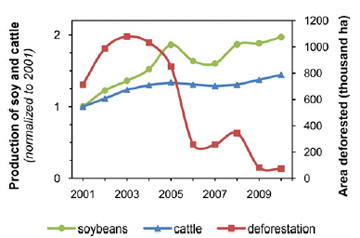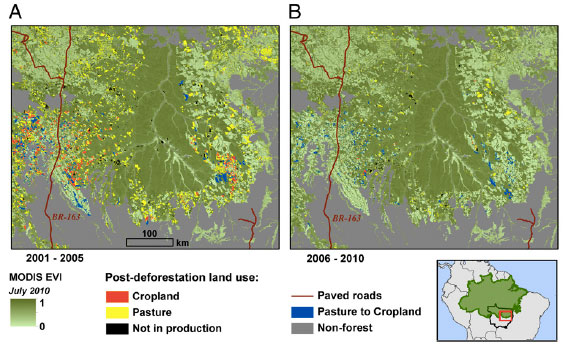New study associates sharp decline in Amazon deforestation with increase in food production.

Soy and forest in Mato Grosso, Brazil. Photo by Rhett A. Butler.
A sharp drop in deforestation has been accompanied by an increase in food production in the Brazilian state of Mato Grosso, reports a new study published in the journal Proceedings of the National Academy of Science. The research argues that policy interventions, combined with pressure from environmental groups, have encouraged agricultural expansion in already-deforested areas, rather than driving new forest clearing.
Marcia Macedo of Columbia University and colleagues analyzed trends in deforestation and soy production from 2001-2010 in Mato Grosso, a state on Brazil’s agricultural frontier where more than a third of forest loss in the Brazilian Amazon has occurred since the 1980s. They found that during the first half of the decade about 26 percent of increased soy production was the result of cropland expansion into forest areas, accounting for about 10 percent of total deforestation during the period. During the second half of the decade (2006-2010), soy expansion amounted to only 2 percent of deforestation. 91 percent of the production increase in the late 2000s occurred on previously cleared cattle pasture. Surprisingly, the researchers found little evidence of “leakage” whereby soy expansion was displaced from forest areas to the savanna-like cerrado.
 Graph courtesy of Macedo et al 2012. |
The authors say the decline coincides with several trends and developments, including “fluctuations in commodity markets and the implementation of several high-profile policy initiatives aimed at restricting credit for deforesters, improving monitoring and enforcement, and excluding deforesters from the supply chains of major exporters.” Notably, the 2005-2010 period included a prominent campaign by Greenpeace, an international environmental activist group, which pressured major soy crushers and traders to adopt a “moratorium” on new forest clearing for soybeans; the “blacklisting” of high deforestation municipalities, which restricted access to credit and subsidies; and the launch of a near-real-time satellite-based deforestation tracking system which facilitated a crackdown on corruption in the environmental enforcement agency IBAMA and other agencies.
The authors argue these factors helped mitigate forest clearing for soya once commodity prices recovered in the aftermath of the worst of the global financial crisis.
“The land-use transitions observed during the postboom period—and the case of 2009 in particular—suggest that when market conditions favored expansion, producers expanded into areas previously cleared for pasture rather than forest areas. These patterns are consistent with the outcomes expected by many of the recent policy interventions, providing some support for the hypothesis that they have helped to suppress deforestation.”
The results seem to offer hope that the combination of private and public sector initiatives have the potential to disaggregate agricultural production from deforestation. But the authors nonetheless warn against complacency. They note that increased investment in infrastructure projects and new technologies will make larger areas of Amazon forests accessible for intensive agricultural production, while proposed reform of the Forest Code which limits how much land a property-holder is allowed to clear, could undermine some of the policy gains for forest conservation.
 (A and B, enlargements of the area boxed in red) Postdeforestation land uses in a subset of the study region from 2001 to 2005 (A) and 2006 to 2010 (B). Deforestation areas >25 ha were derived from the PRODES dataset (11), and land use from analysis of the MODIS EVI time series. The Brazilian Amazon forest biome is shaded in green (Lower Right). Image courtesy of Macedo et al 2012. |
Macedo and colleagues suggest that policies which encourage more efficient use of degraded, non-forest land could help meet future demand for food, without destroying forests.
“Our results suggest that preventing deforestation over the long term will require parallel efforts to modernize the cattle sector and create strong new policy incentives that promote efficient use of degraded lands,” they write. “Recent efforts to model Brazil’s low-carbon development alternatives indicate that the implementation of existing technologies to restore degraded lands and increase pasture productivity could free enough additional land to accommodate projected growth through 2030, although achieving this would be challenging and require substantial private and public investments.”
CITATION: Marcia N. Macedo, Ruth S. DeFries, Douglas C. Morton, Claudia M. Stickler, Gillian L. Galford, and Yosio E. Shimabukuro. Decoupling of deforestation and soy production in the southern Amazon during the late 2000s. PNAS for the week of January 10, 2012. www.pnas.org/cgi/doi/10.1073/pnas.1111374109
Related articles